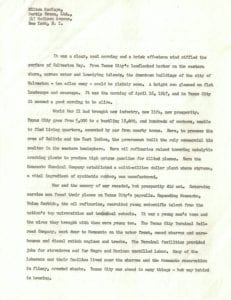This blog post was composed by graduate assistant Jillian Higgins, a master’s student in the History Department.
Following the 1947 Texas City Disaster that left Texas City in a state of ruin, Milton MacKaye – a freelance and government writer from Iowa – authored a twenty-two-page short story outlining the morning of the tragedy and the silence that followed. MacKaye, formerly having worked for the Undersecretary of War during World War II and no stranger to devastating frontlines, illustrates that following the end of the Second World War, memory and war receded from public sentiments and prosperity for young soldiers was nearly non-existent. Young men returned from war as unskilled laborers, and therefore, out of necessity, brought their young wives to oil refinery cities and lived in flimsy, crowded shacks near the Texas waterfront.



In his first pages, MacKaye sets the stage for the Galveston Bay industrial catastrophe, implying that the government was not taking the necessary precautions to prevent such a large-scale accident from happening. On the day of the incident, the French ship – the Grandcamp – was in the harbor with 900 tons of ammonium nitrate fertilizer onboard, waiting to load flour and other mixed cargo. No airplanes flew above to watch for signs of smoke or fire and the oil refineries ran full speed ahead. MacKaye described the moment of the explosion as follows: “It was 9:12. Suddenly, spinning balls of fire shot skyward and the Grandcamp exploded. The result was one of the most fearful disasters in American history, greater in its loss of life than the celebrated San Francisco earthquake and fire. Some 570 people were killed and more than 3,000 injured. Property damage has been estimated $50,000,000” (pg. 6). The chemicals and heat from the explosion had caused a chain reaction of fires and explosions of other ships and Texas City oil refineries.

Perhaps the impact of MacKaye’s literature was not in his powerful description of the incident itself, but rather his choice to expound the stories of individuals who survived the disaster, from a young boy waiting tables at his family’s restaurant to an elderly woman grieving the loss of her husband in utter shock. In doing this, MacKaye humanized the victims of the tragedy. While the nation came to the aid of the survivors’ families, businessmen groaned and wondered if Texas City could ever recover or become prosperous again. The passivity and lack of remorse of wealthy business owners – some of whose oil refineries played a role in the disaster – angered U.S. Representative Clark Thompson of Galveston, who introduced legislation in Congress that would provide compensation to the victims to help them rebuild their towns and lives. Due to Thompson’s tenacity, the bill passed in 1955 and allowed for $17 million to be distributed to over 1,400 claimants. Thompson played an important role in securing a bright future for coastal Texans and Galvestonians, as his efforts stimulated economic recovery in the area.
The Clark Thompson papers are full of materials related to the Texas City Disaster, still counted as one of the largest non-nuclear explosions in history. We welcome you to schedule an appointment with one of our archivists to view more.
Sources
“Death on the Waterfront” by Milton MacKaye, undated. Clark W. Thompson papers, Accession #100, Box 93, Folder 11, Baylor Collections of Political Materials, W. R. Poage Legislative Library, Baylor University.
Photo of automobiles: University of Houston Digital Library. English: Texas City Disaster. Parking Lost 1/4 of a Mile Away from the Explosion. Courtesy of Special Collections, University of Houston Libraries.
Photo of Texas City After: Browning, Robert L. Texas City. Negative no. 1120-49. Clark W. Thompson papers, Accession #100, Box 95, Folder 11, Baylor Collections of Political Materials, W. R. Poage Legislative Library, Baylor University.
Photo of Texas City Before: Browning, Robert L. Texas City. Negative no. 1500-6. Clark W. Thompson papers, Accession #100, Box 95, Folder 11, Baylor Collections of Political Materials, W. R. Poage Legislative Library, Baylor University.